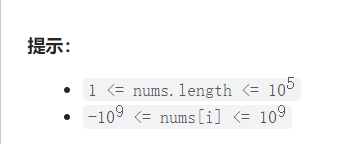- 8IC7(V_NVVF3.png
 ">217存在重复元素
- 4HTZ]T9T7.png
![R_X{DTSGDO$76@7MIMLB5]5.png](/uploads/projects/rui17@eisp2e/df211bdf8d507ff5dc56f97c011cf883.png) ">705设计哈希集合![]R35BAF~1L1484HTZ]T9T7.png
">705设计哈希集合![]R35BAF~1L1484HTZ]T9T7.png![R_X{DTSGDO$76@7MIMLB5]5.png](/uploads/projects/rui17@eisp2e/df211bdf8d507ff5dc56f97c011cf883.png)
217存在重复元素
思路:
数组存在重复元素,可以将数组排序,然后再遍历判断,但是这样的复杂度是 NlogNNlogN,但是,一般会选择牺牲空间保时间,所以使用哈希表来解决这道题,让时间复杂度为 NN。
流程如下:
创建一个哈希表,然后从左往右遍历数组。
检测哈希表中是否已存在当前字符,若存在,直接返回结果,若不存在,将当前字符加入哈希表,供后续判断使用即可。
代码
class Solution {public boolean containsDuplicate(int[] nums) {Set<Integer> set = new HashSet<Integer>();for (int x : nums) {if (!set.add(x)) {return true;}}return false;}}
#使用set()class Solution:def containsDuplicate(self, nums: List[int]) -> bool:nlen = len(nums)if not nlen:return Falsenums.sort()l = [nums[0]]for i in range(1,nlen):if l[-1] ^ nums[i] != 0:l.append(nums[i])else:return Truereturn False#排序并比较相邻元素是否相同class Solution:def containsDuplicate(self, nums: List[int]) -> bool:nlen = len(nums)if nlen != len(set(nums)):return Truereturn False
705设计哈希集合![]R35BAF~1L1484HTZ]T9T7.png![R_X{DTSGDO$76@7MIMLB5]5.png](/uploads/projects/rui17@eisp2e/df211bdf8d507ff5dc56f97c011cf883.png)
思路
java:
简单数组
题目给出了 0 <= key <= 10^6 数据范围,同时限定了 key 只能是 int。
可以直接使用一个 boolean 数组记录某个 key 是否存在,key 直接对应 boolean 的下标。
链表
python:
哈希函数中的键值一般要%于一个底数,底数一般为素数,题目指出最多调用次数为10^4, 所以底数一般为三到四位数的素数即可,巧用Python的二维数组
代码
class MyHashSet {boolean[] nodes = new boolean[1000009];public void add(int key) {nodes[key] = true;}public void remove(int key) {nodes[key] = false;}public boolean contains(int key) {return nodes[key];}}class MyHashSet {// 由于使用的是「链表」,这个值可以取得很小Node[] nodes = new Node[10009];public void add(int key) {// 根据 key 获取哈希桶的位置int idx = getIndex(key);// 判断链表中是否已经存在Node loc = nodes[idx], tmp = loc;if (loc != null) {Node prev = null;while (tmp != null) {if (tmp.key == key) {return;}prev = tmp;tmp = tmp.next;}tmp = prev;}Node node = new Node(key);// 头插法// node.next = loc;// nodes[idx] = node;// 尾插法if (tmp != null) {tmp.next = node;} else {nodes[idx] = node;}}public void remove(int key) {int idx = getIndex(key);Node loc = nodes[idx];if (loc != null) {Node prev = null;while (loc != null) {if (loc.key == key) {if (prev != null) {prev.next = loc.next;} else {nodes[idx] = loc.next;}return;}prev = loc;loc = loc.next;}}}public boolean contains(int key) {int idx = getIndex(key);Node loc = nodes[idx];if (loc != null) {while (loc != null) {if (loc.key == key) {return true;}loc = loc.next;}}return false;}static class Node {private int key;private Node next;private Node(int key) {this.key = key;}}int getIndex(int key) {// 因为 nodes 的长度只有 10009,对应的十进制的 10011100011001(总长度为 32 位,其余高位都是 0)// 为了让 key 对应的 hash 高位也参与运算,这里对 hashCode 进行右移异或// 使得 hashCode 的高位随机性和低位随机性都能体现在低 16 位中int hash = Integer.hashCode(key);hash ^= (hash >>> 16);return hash % nodes.length;}}
class MyHashSet:def __init__(self):self.base = 799self.hash_set = [[] for i in range(self.base)]def hash_key(self, key: int):return key%self.basedef add(self, key: int) -> None:hash_pos = self.hash_key(key)if key in self.hash_set[hash_pos]:passelse:self.hash_set[hash_pos].append(key)def remove(self, key: int) -> None:hash_pos = self.hash_key(key)if key not in self.hash_set[hash_pos]:passelse:self.hash_set[hash_pos].remove(key)def contains(self, key: int) -> bool:hash_pos = self.hash_key(key)if key in self.hash_set[hash_pos]:return Trueelse:return False# Your MyHashSet object will be instantiated and called as such:# obj = MyHashSet()# obj.add(key)# obj.remove(key)# param_3 = obj.contains(key)

